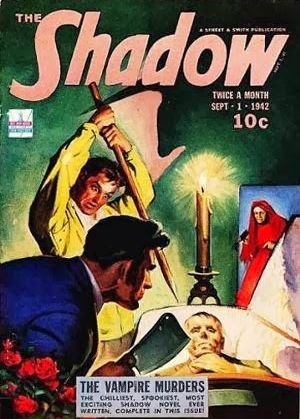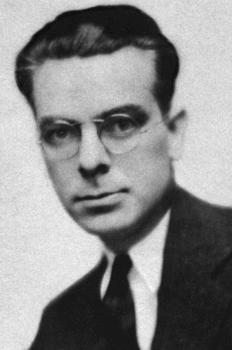Happy Birthday, Walter B. Gibson!
Posted by Ivan G. Shreve, Jr. on Sep 12th 2015
When it came to pulp fiction, Street & Smith were among the leaders in that particular kingdom of the publishing world—the company churned out a large number of weekly magazines, comics and inexpensive novels during their reign from 1855 to 1949 (the year S & S began selling off some of their titles) and were undeniably shrewd promoters of their own product. For example, Street & Smith began sponsoring a radio program on CBS starting on July 31, 1930 to plug Detective Story Magazine—a series appropriately titled The Detective Story Hour. Ostensibly an anthology program that dramatized tales originally printed in Detective Story, the narrator of the show—a mysterious character identified as “The Shadow” (played by James LaCurto, then Frank Readick)—quickly began to attract attention among the series’ devoted listeners.
That attention came in the form of Street & Smith Publishers being constantly asked where folks might purchase magazines with “that Shadow character from the radio.” To address the high demand for a magazine they technically didn’t publish (yet), the company asked an author who had recently submitted some stories for Detective Story Magazine to produce 75,000 words for the premiere issue of The Shadow Magazine. That tale, “The Living End,” was published under the nom de plume of Maxwell Grant…but the author’s real name was Walter Brown Gibson, and he was born 118 years ago on this very date.

Gibson entered this world in the Germantown neighborhood of Philadelphia, PA, to Alfred Cornelius and May Morrell Whidden Gibson. After graduating from Colgate University in 1920, Walter became a member of the fourth estate: he worked on such newspapers as the Philadelphia North American and (later) The Evening Ledger, as a reporter and crossword puzzle designer. Macfadden Publications hired him in 1928 to edit a magazine entitled True Strange Stories (he went by “Walter Scofield” at that time), and three years later he embarked on his Street & Smith Shadow venture—publishing the equivalent of 283 novels out of an eventual 325 on the invisible crimefighter (about 24 novels a year!).
Walter Gibson described himself as a “compulsive writer,” and the proof of that is his churning out an estimated 1,680,000 words a year. In addition to his contribution as the Shadow’s official chronicler (Gibson more or less created the mythos of the pop culture favorite), Walter was also the author of a daily newspaper comic strip featuring the famed mystery man in the 1940s, and he penned many of The Shadow’s comic book adventures as well. Gibson also served as a consultant to the radio series, which became known as The Blue Coal Mystery Revue in 1932, and in the fall of 1937 put The Shadow center stage with Orson Welles voicing the man who could cloud men’s minds so that they couldn’t see him. Moving back and forth between the publishing and radio worlds was not without controversy, however. The Shadow’s identity on radio was “wealthy young man-about-town” Lamont Cranston, but in the novels and stories The Shadow used “Cranston” as a disguise to cover his real identity: former WW1 aviator Kent Allard. The Shadow’s “friend and companion” Margo Lane was also a pure radio addition (to add some female interest to the series)—Margo wasn’t introduced to the printed page until 1941…and more than a few readers objected strongly to this.

Because he decided sleep was for the weak (okay, I’m just making a joke here), Walter Gibson didn’t just limit his writing activity to the adventures of The Shadow. Gibson published books on such subjects as true crime, yoga, hypnotism and games, and as an accomplished magician Walter wrote on magic, psychic phenomena/occult and rope tricks. The author was quite well-known as a “ghost writer” on books published by Harry Houdini, writing on Houdini’s legendary escapes and feats of magic (and he was an active participant in the “séances” conducted to contact Harry in the next world as well). Gibson contributed to the “literary efforts” of mentalist Joseph Dunninger and fellow prestidigitator Harry Blackstone, Sr. Blackstone was the subject of a quarter-hour radio drama entitled Blackstone, the Magic Detective that ran weekly on Mutual from 1948-49; Walter contributed to those scripts as well as the comic book series inspired by Blackstone’s fictional exploits.
If you’ve ever perused the items for sale in your local magic shop and found yourself distracted by the “nickels to dimes” illusion…well, you can award the credit to Walter Gibson; he also introduced the “Chinese linking rings” trick to American audiences as well. Gibson never called it a day with his love of writing, by the way—he brought back The Shadow in 1963 with the appropriately titled Return of the Shadow (his last Shadow novel had been released in 1949), and as “Andy Adams” penned five entries in the Biff Brewster juvenile adventure book series between 1960 and 1965. Walter would continue writing books and short stories until he left this world to really look for Houdini with his passing in 1985.
Celebrate the birthday of the man who truly knows “what evil lurks in the hearts of men”: Walter Gibson!

